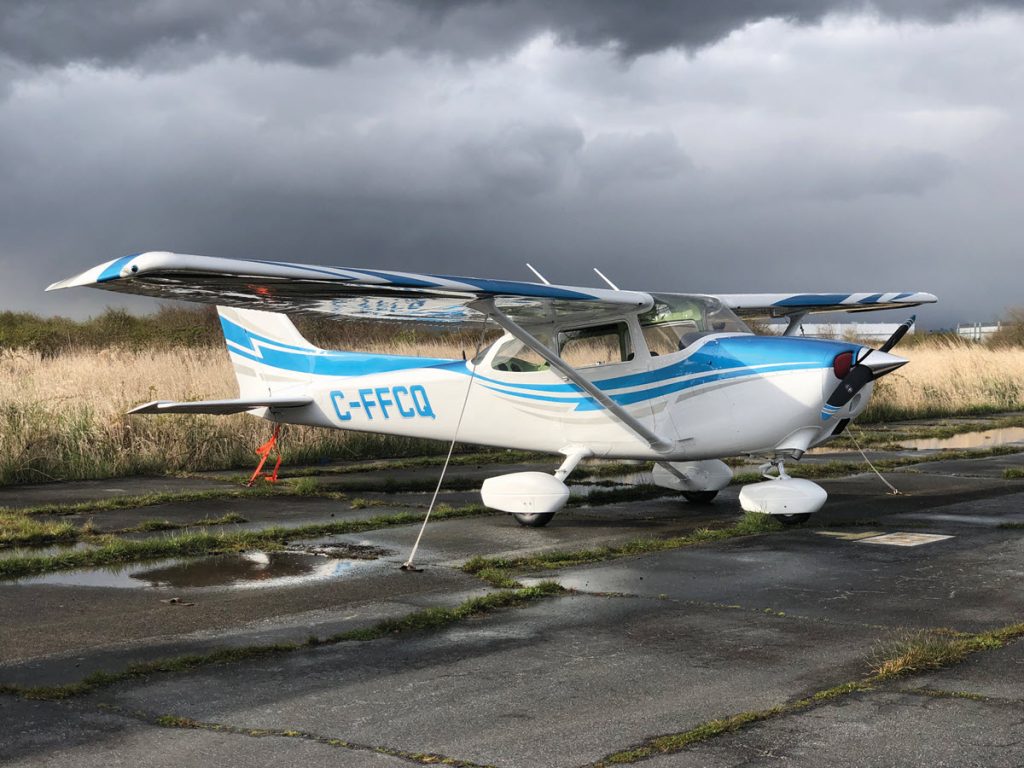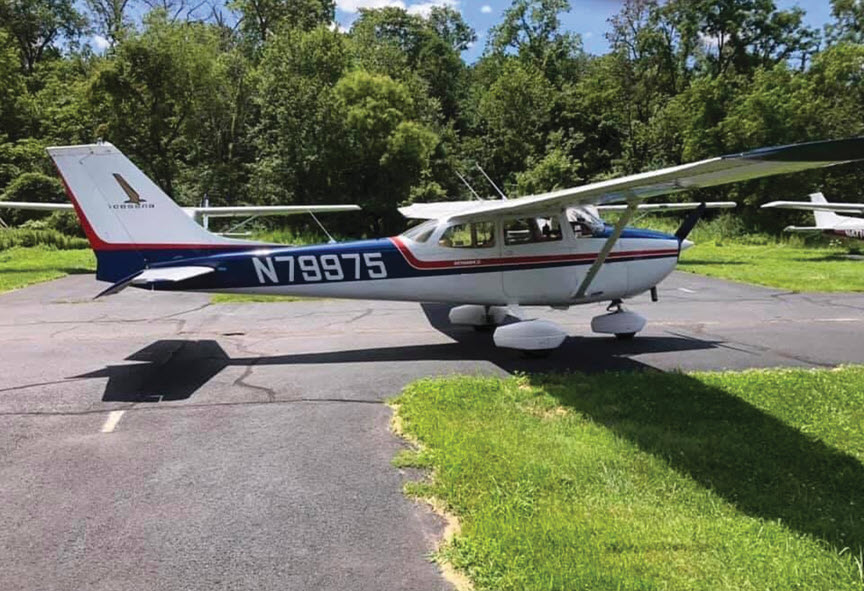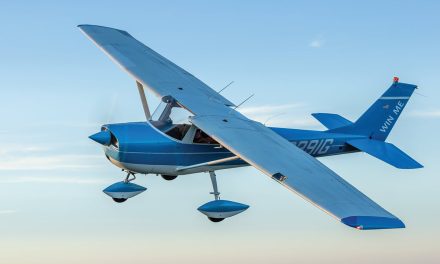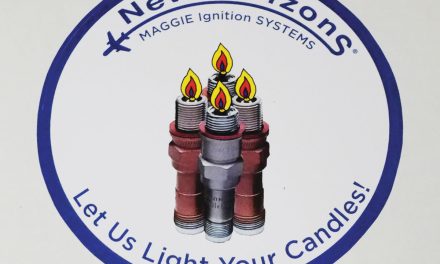In-Depth Reviews and Advice from Skyhawk Owners
By Dan Brownell

The Skyhawk is the most produced aircraft in history. With more than 44,000 built and more still being produced, they are as popular now as ever. As 172 owner Michael Renforth points out in the State of the Used Market section in the following report, a new C172 can sell for more than $450,000. The original 1956 172 was listed at just $11,751, which gives some perspective on just how values have climbed over the years.
The iconic type has been widely used for training since its inception and is a great all-around model. It’s known as a model that doesn’t really excel at anything but provides a generally good, well-balanced performance. No wonder it’s been such a mainstay for nearly seven decades.
Skyhawk Reviews and Tips from COO Members
172 Pre-Purchase Tips
Gary Anderson, Sheridan, WY, 1956 172
- Have a qualified A&P perform a good prebuy inspection.
- Have a title search done for any liens or judgments against the aircraft.
- Do complete AD research of the aircraft and all components.
- Look for NTSB reports of any accidents or damage history.
- Check if the N number has been changed. This can be a way to hide history that the seller doesn’t want you to know.
Alan Miles, Miami Beach, FL, 1973 172 M
- Get an expert to help.
- Decide on your mission and stick with it.
- Pay cash, or you can’t afford it.
Bill St. John, Panama City, FL, 1978 172N Skyhawk II
- Get a 180 hp upgrade from Air Plains in Wellington, Kansas.
- Get all the nav/comm, etc., you can afford.
Bryan Boyle, Morrisville, PA, 1969 172K
- Have a prebuy by a mechanic of your choice. That’s not to imply that previous IAs may have not been entirely candid, but a fresh set of eyes — considering the investment you’re looking to make — is never a bad choice and may save you big money down the road.
- If you’re able and qualified, test fly the plane in question with the owner, or someone he designates.
- 172s are the “everyman” workhorse of the training and entry-level fleet, but even so, it’s good to actually put it through its paces. Stalls, slow flight, steep turns, maybe a commercial maneuver or two will tell you more about the rigging and correctness of all the fittings than a ground-constrained preflight inspection.
- Budget 50% of the purchase above and beyond for the first year’s unanticipated issues. It’s less expensive in the long run to spend a little more for a plane that has 90% of what you want than start with a bare shell and build it the way you want. Been there, done that.
Charles Luzz, Andover, MA, 1975 172M
Models up through 172N had no factory primer applied and, as a result, many have corrosion, some more serious than others. Remove the interior to bare metal and open all inspection panels, especially the wing and tail group and examine with a borescope. Hidden, hard-to-reach corrosion that can’t be fixed is grounds to walk away.
Joseph Ritchie, Yorktown, VA, 1974 172M
Check for corrosion, control surface and linkage integrity, and avionics.
Kenneth Brownell, Leverett, MA, 1966 172G
- Look for corrosion, especially if the plane has been tied down outside for any length of time.
- Carefully review maintenance logs. Are items that should be there missing? What original components have been replaced, and what has not?
- Don’t get wowed by new paint, seats, carpet, etc.
Mark Frumkin, McMurray, WA, 1980 172RG
Fly the plane. It should fly hands off with just a small touch of trim. While you’re up there, get a radio check with ATC, including transponder and altitude. If these are OK, have a thorough inspection done, including oil and filter opened.
Mark Nevins, Gresham, OR, 1967 Cessna 172H
Check strut attachments and above the headliner.
Michael Renforth, Chesapeake, VA, 1982 172P
- Watch out for what others have done. If the autopilot isn’t talking to the GPS, look for the cut wires and handheld plug installed instead of troubleshooting the intermittent.
- Thoroughly review the logbooks. Try to figure out if the “other” things were done, like the switch replacement (four years), elevator torque tube inspections (20 years, then recurrent), and flexible fuel lines replaced. Mine had an intermittent fuel smell and I found fuel literally seeping through the original fuel lines at the wing root.
- There will be corrosion. Even the cleanest aircraft will have some somewhere. The question is how much and what to do about it. In early- to mid-70s models, look for filiform corrosion under the early Imron, which leads to pitting. For later models, check every single lead pad glued to the skin with the notorious hydroscopic glue. At annual, look for stuff people did that looks out of place, such as a piece of sponge jammed behind a flap follower cable, which will reduce the housing to crumbles. If it looks out of place, check it out; it probably is.
Sam Parsons, Orlando, FL, 1975 172M
- Inspect for corrosion, especially if near an ocean.
- Test the radios in the air to determine reception range.
- Inspect the nosewheel steering bars and where they attach to the rudder pedals.
Steve Watkins, Roxboro, NC, 1978 and 1975 172s
- Do a prebuy.
- It’s better to find a plane with the desired avionics than to upgrade.
- Find a plane that’s been flown regularly since the last engine overhaul.
Tom Braeunig, Hubbard, OR, 1975 172M
- Take your time looking. Search all the aircraft-for-sale websites: Trade-a-Plane, Barnstormers, Controller.com, etc., and get on their mailing lists to get email alerts for new listings. Also search local listings and talk to local A&Ps and pilots. They may know of airplanes that might be for sale before they hit the market. [Ed. Note: Also visit the website of COO partner Van Bortel Aircraft, vanbortel.com.]
- Once you find a likely prospect, find out if the aircraft logs are available in digital format. Download the logs and do a thorough search to determine things like damage history, AD compliance, how frequently the plane has been flown, engine compressions, time since major overhaul, etc. Savvy Aviation has a complimentary logbook examination service that will spot any red flags.
- Once you find a plane that looks like a good candidate, arrange to look at the plane, and fly the plane in both calm air and in light turbulence, if possible, to see how it handles, if it flies straight hands-off, and how responsive it is on controls.
- Look for corrosion, especially in the wing spars, above the headliner, and behind the kick panels in the front cabin. Some structural corrosion can be unrepairable and is a deal-killer.
Pre-Purchase Checklist
We asked owners for pre-purchase ideas that most people wouldn’t think of.
Gary Anderson, Sheridan, WY, 1956 172
Has the aircraft been modified? If so, has the proper paperwork been filed with the FAA? Has the continued airworthiness maintenance been performed? Also check if any ADs apply to this modification.
Brad James, Vancouver, BC, Canada, 1974 172M
Corrosion above the headliner, corrosion on the cam and lifters, and the cost of replacing the old interior plastic pieces.
Bryan Boyle, Morrisville, PA, 1969 172K
The condition of the universal joints for the fuel selector. That control very rarely moves, but if you have to move it, you really don’t want it coming off in your hand because the selector valve was corroded in the On position.
Charles Luzz, Andover, MA, 1975 172M
Check for airframe corrosion inside the wing (spars and skins) and in the tail group. The rear windshield often suffers decades of rain and wash-water leakage and can corrode away the retainers.
Dave Cohen, Winter Garden, FL, 1967 172H
Make sure all the manuals are included (or can be obtained). For nav systems and autopilots, either have the seller teach you how to use them, or make sure courses are available somewhere.
Joseph Ritchie, Yorktown, VA, 1974 172M
The carburetor air box integrity. It’s very expensive to replace.
Kishore Patel, Nairobi, Kenya, 1973 172J
Unlogged repairs carried out on the aircraft.
Mark Frumkin, McMurray, WA, 1980 172RG
Check the rudder trim.
Mark Nevins, Gresham, OR, 1967 Cessna 172H?
Real pushrod tube and valve cover set; Hooker harnesses; oil filter adapter.
Michael Renforth, Chesapeake, VA, 1982 172P
Everyone thinks about the ADs, but you should create an account with Textron and check the Cessna Service Bulletins. They may not be mandatory by regulation, even if they say mandatory, but there’s a lot of valuable information there that even experienced A&Ps don’t know about — the switch replacement, for example, and I’m not bragging here. I fried the landing light switch, which got me digging. Taught my A&P something.
Sam Parsons, Orlando, FL, 1975 172M
Check whether the nose wheel steering is normal, and inspect the connection to the pilot’s rudder pedals to make sure the connection points are not elongated.
Thomas Jeffries, Greenwood, IN, 172M, 172N
The flap track; use a gauge to check it. If the track needs to be replaced, it’s labor intensive.
Tom Braeunig, Hubbard, OR, 1975 172M
Check for structural corrosion in the inboard wing spar top angle (bulb angle). The first 172 I looked at had unrepairable corrosion in this area, so I terminated the sale. Airframe Components in Kendallville, Indiana, has a lot of experience rebuilding and repairing Cessna wings and could probably give some guidance on exactly what to look for. One other thing would be to have the inspecting mechanic check the rigging to make sure the flight control rigging is within factory specs.
How Does the 172 Compare?
172 vs. 150
Brad James, Vancouver, BC, Canada, 1974 172M
The 172 is bigger, faster, and climbs better.
172 vs. 182
Brad James, Vancouver, BC, Canada, 1974 172M
The 172 is slower and smaller, but the overall operational costs are significantly less.
Tom Braeunig, Hubbard, OR, 1975 172M
The 172 is a much more economical plane to own and operate, considering fuel consumption and maintenance (especially with the Lycoming engine). Insurance is probably a little cheaper. The 182 is a much more comfortable, stable plane, more suited to cross-country flying. It’s a true four-place plane, whereas the 172 is easy to overload.
172 vs. 205
Ed Sunday, Sonora, CA, 1966 172G
The 172 is like flying a feather. The 205 flies like a rock. The 172 is a simple machine that’s easy to work on and obtain parts for but isn’t very fast. The 205 is more complex to fly and maintain and is a bit of an oddball.
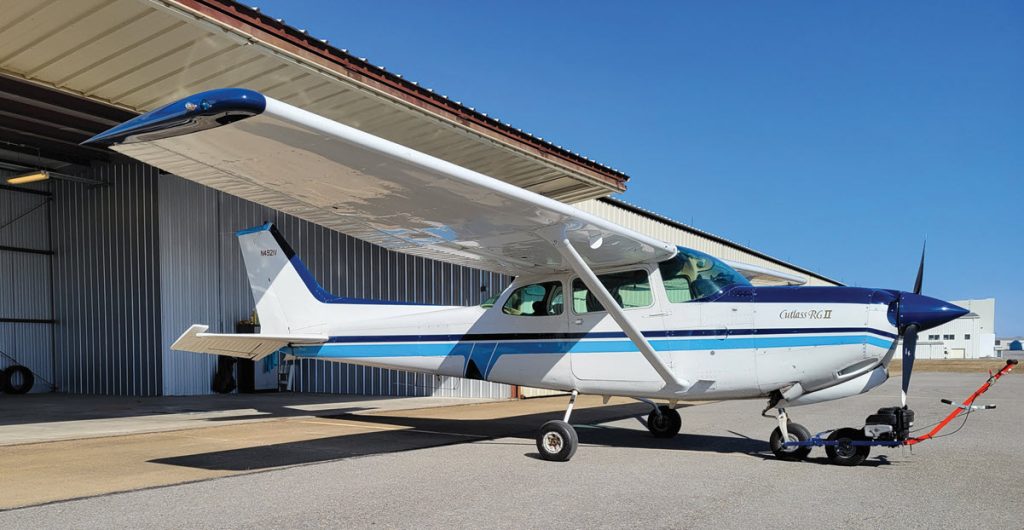
172 vs. Cherokee
Bryan Boyle, Morrisville, PA, 1969 172K
Deep down, I’m a Hershey bar Cherokee guy. But decent ones are few and far between and have been for a while. So when my 172 became available, I jumped in. I’ve owned both and, as a CFI, I’ve taught in both.
Speed: Let’s face it; neither are rocket ships capable of warp travel.
Advantages: The advantages of the 172 are that they’re widely used at flight schools (Cessna really seeded the market with their Integrated Flight Training curriculum). And they’re predictable.
Stall break: 172s can have a noticeable stall break and tend to drop off one side or the other. You can get the Cherokee to break, but you have to work at it. The wing, especially a power-on 180 or Archer stall, will just mush.
Landing: You can grease a landing on a Cherokee if you nail the speeds right, just as you can in a Cessna. In a crosswind, though, the Cherokee, with its lower wing, is deeper in ground effect than the 172; consequently, the transition is a bit different in the flare. I give the Vero Beach a plus over Wichita here. But neither have any serious vices that will catch you if you pay attention.
Maintenance: It’s a toss-up. They cost what they cost, though some of the stock parts from Textron, for what they are, are eye-wateringly expensive.
Dave Cohen, Winter Garden, FL, 1967 172H
The 172 cabin is slightly wider than the Cherokee. There’s also an added safety factor with doors on both sides.
Mark Nevins, Gresham, OR, 1967 172H
The 172’s nose oleo strut is the only advantage. Its tendency to float more on landing can be a disadvantage.
172 vs. PA-28
Thomas Jeffries, Greenwood, IN, 172M, 172N
Pipers are great airplanes, but one door is a drawback. They’re difficult to get into. It’s not a problem for a young man but becomes more difficult as the years go on. We operate 12 C172s. They’re relatively easy to maintain.
172 vs. RV-6A
Brad James, Vancouver, BC, Canada, 1974 172M
The 172 is way slower and not nearly as sporty, but you can take four people or a lot of stuff with you and the landing gear is more robust.
172 vs. Bonanza
Mark Frumkin, McMurray, WA, 1980 172RG
With the 172, you get more flight hours on every trip and 50% less fuel burn. Annuals and insurance cost a lot less. The plane costs less, too.
What Should Always Be Upgraded/Restored on a Used 172?
Gary Anderson, Sheridan, WY, 1956 172
- You may need to upgrade the instrument panel and radios. Also, it may need ADS-B installed.
- Check the times on the engine. It may be at or past TBO. Under Part 91, you are not required to overhaul, but you do need to monitor that component for any signs of abnormalities.
Bill St. John, Panama City, FL, 1978 172N Skyhawk II
- Engine upgrade to 180 hp.
- Replace all electronics with newer equipment to include ADS-B and GPS.
Brad James, Vancouver, BC, Canada, 1974 172M
Inspect for and deal with any corrosion you find. As these planes age, all the defects big and small accumulate to the point that most of the ones out there actually need restoration as opposed to “fixing.”
Bryan Boyle, Morrisville, PA, 1969 172K
- Shimmy dampener and front scissor assembly.
- Inside plastic, as needed. The old Royalite crumbles if you look at it.
- Check and rig properly the control cables.
- Check and replace pulleys as needed.
- Tires. If they look old, they are.
- Baffle seal. The newer silicone versions work a lot better than the old fiber/rubber compositions.
Charles Luzz, Andover, MA, 1975 172M
- Flap tracks.
- Seat tracks.
- Engine baffles.
Dave Cohen, Winter Garden, FL, 1967 172H
It totally depends on the user. Modern avionics/nav are a must for IFR pilots. Those going on trips may want comfortable seats. There is a safety/efficiency argument for making sure you have a few years left until TBO on the engine.
Ed Sunday, Sonora, CA, 1966 172G
Vortex generators are fairly inexpensive but with big results.
Joseph Ritchie, Yorktown, VA, 1974 172M
The avionics and interior.
Kenneth Brownell, Leverett, MA, 1966 172G
Make sure the ELT has been upgraded.
Kishore Patel, Nairobi, Kenya, 1973 172J
Engine gauges and avionics. Original fuel gauges are very unreliable.
Mark Frumkin, McMurray, WA, 1980 172RG
- Nav/comms and transponders don’t last forever.
- Add GPS if it’s not in there.
Mark Nevins, Gresham, OR, 1967 Cessna 172H?
- Flap rollers.
- Addition of oil filter adapter.
- STC for Mogas.
- LED nav, landing and taxi lights.
- Addition of avionics master switch and circuit.
- Apareo ADS-B and Stratus.
- IFR panel; Hooker harnesses; Real pushrod tube and valve cover kits.
Sam Parsons, Orlando, FL, 1975 172M
- The Sportsman wing mod and new wingtips with landing lights. The Sportsman wing really helps in climb rate and slow flight with no penalty in cruise. A power-on stall is really hard to do.
- The wingtip LED landing lights in wigwag mode make you super visible to other traffic.
Steve Watkins, Roxboro, NC, 1978 and 1975 172s
Avionics.
Thomas Jeffries, Greenwood, IN, 172M, 172N
Avionics and interior, in that order.
Tom Braeunig, Hubbard, OR, 1975 172M
It all depends. There are some pristine 172s out there that wouldn’t need anything upgraded. But even with a corrosion-free airframe and low-time engine, perfect paint and interior, there’s no end of avionics upgrades that could be done to suit your mission.
Ty Ashe, Notasulga, AL, 1985 172P
Avionics. Garmin 275, Garmin 175, and G500 autopilot, make it a TAA aircraft for commercial pilot training.
Jim Pantas, Mount Pleasant, NC, 1964 172E
Seat tracks and windows.

What is the Best Reason to Buy and/or Fly This Aircraft?
Gary Anderson, Sheridan, WY, 1956 172
It’s a very easy aircraft to learn to fly and it won’t break the bank. It’s a good aircraft for cross-country flights. You may not get there as fast as you would in a faster aircraft, but you will have more spending money when you get there
Bill St. John, Panama City, FL, 1978 172N Skyhawk II
Popularity equals maintenance and parts availability/familiarity.
Brad James, Vancouver, BC, Canada, 1974 172M
The 172 isn’t fast, but it can get you flying economically, and finding parts for it is not a challenge.
Bryan Boyle, Morrisville, PA, 1969 172K
The best reason? Where else can you travel, with a good tailwind, at 140-150 kts eastbound at 6 or 7 thousand feet on less than 10 gallons/hour? (OK, so the other way would not be so good, but you take it when you can.) Most people learned how to fly in one, so it’s familiar. And the insurance for a reasonable hull value can be relatively inexpensive. And there is not a single shop that can’t work on it if you need help.
Can you load four seats full of typical Americans, full fuel, and 120 pounds in the baggage? No, but certainly for the empty nester with time to travel, it’s an inexpensive (as much as anything is in this avocation) way to exercise the privileges of your certificate.
It’s one of the most economical ways of joining the family of aircraft owners out there.
Charles Luzz, Andover, MA, 1975 172M
It has a safe, predictable behavior. It’s very forgiving and will take you anywhere.
Dave Cohen, Winter Garden, FL, 1967 172H
It flies like every other 172 that’s out there. Its low-speed handling is consistent across the Skyhawk family from the ‘60s to today.
Ed Sunday, Sonora, CA, 1966 172G
For older pilots, it has reasonable insurance costs, and it’s easy to maintain and work on.
Joseph Ritchie, Yorktown, VA, 1974 172M
They’re fairly cheap to operate.
Kenneth Brownell, Leverett, MA, 1966 172G
Safety, reliability, and easy to insure.
Kishore Patel, Nairobi, Kenya, 1973 172J
It’s a workhorse but needs an upgrade on the horsepower.
Mark Frumkin, McMurray, WA, 1980 172RG
If you love to be in the air goose-necking around, this is the ticket. Multiple instrument approaches won’t break the bank even at $6 a gallon. It’s just fun to fly.
Mark Nevins, Gresham, OR, 1967 Cessna 172H?
Its economy and versatility, and it’s easier to fly and insure.
Michael Renforth, Chesapeake, VA, 1982 172P
It’s the most produced aircraft of any type, period. It’s honest, and versatile, with a better useful load than a new Tecnam P2010 if not as fast. It’s not stellar in any one category, but adequate in all: light IFR/training, check. Short/soft, check. Primary flight, check. Sightseeing with grandkids, check. And with 44,000 and counting, getting parts, whether from Cessna or McFarlane or elsewhere, is almost assured.
Sam Parsons, Orlando, FL, 1975 172M
It’s easy to land, has good economy, and has available parts.
Steve Watkins, Roxboro, NC, 1978 and 1975 172s
One of the best entry-level airplanes to fly on the basis of cost-per-hour vs. speed.
Thomas Jeffries, Greenwood, IN, 172M, 172N
Reliability.
Tom Braeunig, Hubbard, OR, 1975 172M
Low maintenance and operating costs.
Ty Ashe, Notasulga, AL, 1985 172P
Expenses are low and it’s very reliable.
Jim Pantas, Mount Pleasant, NC, 1964 172E
Ease of obtaining parts.

What is the State of the Used Market for the 172?
Alan Miles, Miami Beach, FL, 1973 172 M
Very hot in 2022.
Brad James, Vancouver, BC, Canada, 1974 172M
The good ones are getting rare unless you can afford a newer one.
Bryan Boyle, Morrisville, PA, 1969 172K
If you didn’t get in in 2017-2018, you’re going to pay 70% more for the same rig. What would have cost you $30-40,000 in 2018, I’m seeing offers of planes with less equipment than mine (maybe fewer hours on the engine) for more than $90,000.
Charles Luzz, Andover, MA, 1975 172M
Prices have doubled and almost tripled in the last two years.
Dave Cohen, Winter Garden, FL, 1967 172H
It’s a huge seller’s market! Flight schools will pay top dollar for them.
Kishore Patel, Nairobi, Kenya, 1973 172J
Prices have gone up due to price of parts. Sellers are cashing in on average-condition aircraft. Buyers have to spend a small fortune to restore the aircraft to reasonable condition.
Michael Renforth, Chesapeake, VA, 1982 172P
I bought above the market at $150,000 in September 2020. The latest vRef is $189,000. I just saw a 172N listed at $233,000 but compare that to a new one at over $450,000 and it kind of still seems like a bargain.
Tom Braeunig, Hubbard, OR, 1975 172M
Prices have increased steadily over the past few years, and they can vary drastically within the same model and year depending on condition and how the plane is equipped. Prices may have begun to level off a bit lately.
Miscellaneous Tips
Gary Anderson, Sheridan, WY, 1956 172
This model of aircraft is a very popular model for training, so beware of that when purchasing one.
Brad James, Vancouver, BC, Canada, 1974 172M
If you want a glass panel, the pre-1976 models will be expensive to modify to get them to fit.
Bryan Boyle, Morrisville, PA, 1969 172K
Don’t be afraid of a little rough paint (paint doesn’t fly the plane), as long as the bones are OK. If you’re serious (you have the cash in hand or financing set up and ready), and you find your 172, you can’t go wrong with this everyman plane and can look forward to plenty of good times flying your 172.
Kishore Patel, Nairobi, Kenya, 1973 172J
The 172 is very cheap to maintain, but the price of parts has skyrocketed.
Charles Luzz, Andover, MA, 1975 172M
Older 172s have engines that can burn unleaded fuel and mogas, which is slightly less expensive and doesn’t foul the plugs or valves with lead deposits.
Dave Cohen, Winter Garden, FL, 1967 172H
Know where you’re going to keep the airplane before you close on it!
Joseph Ritchie, Yorktown, VA, 1974 172M
Change the incandescent landing lights to LED.
Mark Frumkin, McMurray, WA, 1980 172RG
Retractable gear has been no trouble at all. Keep the fluid reservoir full. And it’s gear up or gear down. Don’t reverse in transit!
Michael Renforth, Chesapeake, VA, 1982 172P
Invest in a set of Vampliers, PB Blaster, screw extractors (your choice, but “Speed Out” is only good for about two screws, and I’ve actually had the extractor snap) and maybe a knocker. All these are better than destroying a buried nut plate drilling through, and the next guy will thank you profusely.
Sam Parsons, Orlando, FL, 1975 172M
A panel upgrade to a modern GTN, audio panel, and two G5s or 275s will be about $30,000. But wow, is it ever worth it!
Thomas Jeffries, Greenwood, IN, 172M, 172N
Over the years, we have seen various modifications that people have done to these airplanes and most of them are not impressive. If you want to do some serious flying and you see a hodge-podge panel, you should probably think twice about the airplane. Just move on to the next one. Don’t be in a hurry.
Ty Ashe, Notasulga, AL, 1985 172P
The 180 hp conversion is a must!

